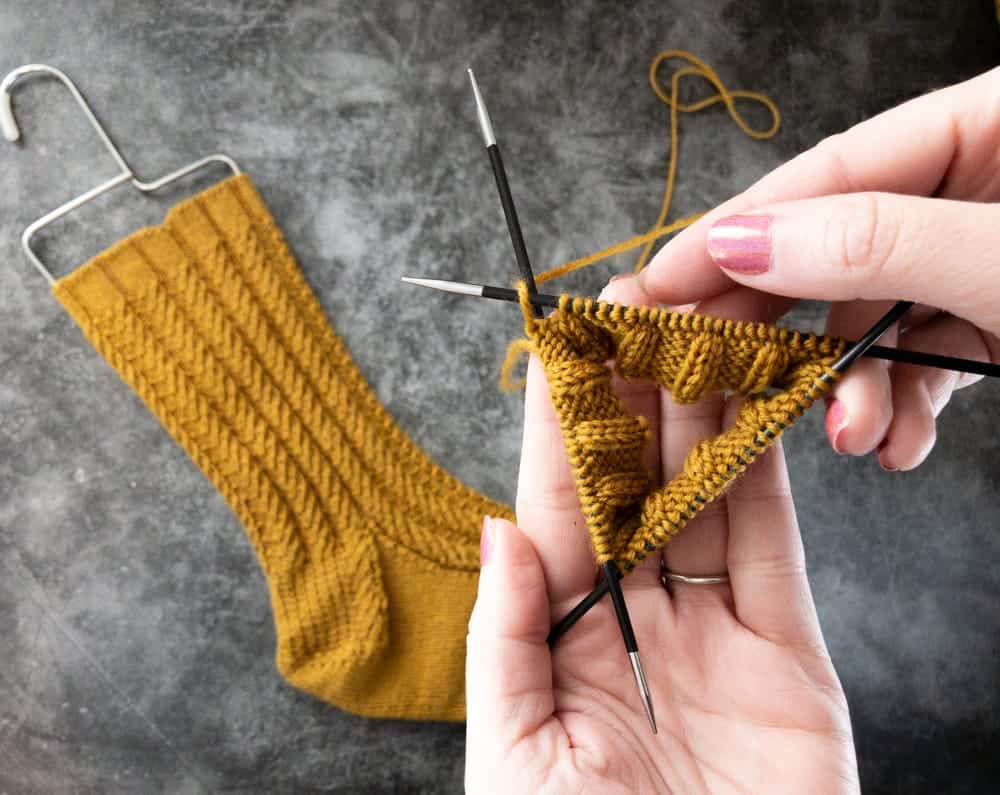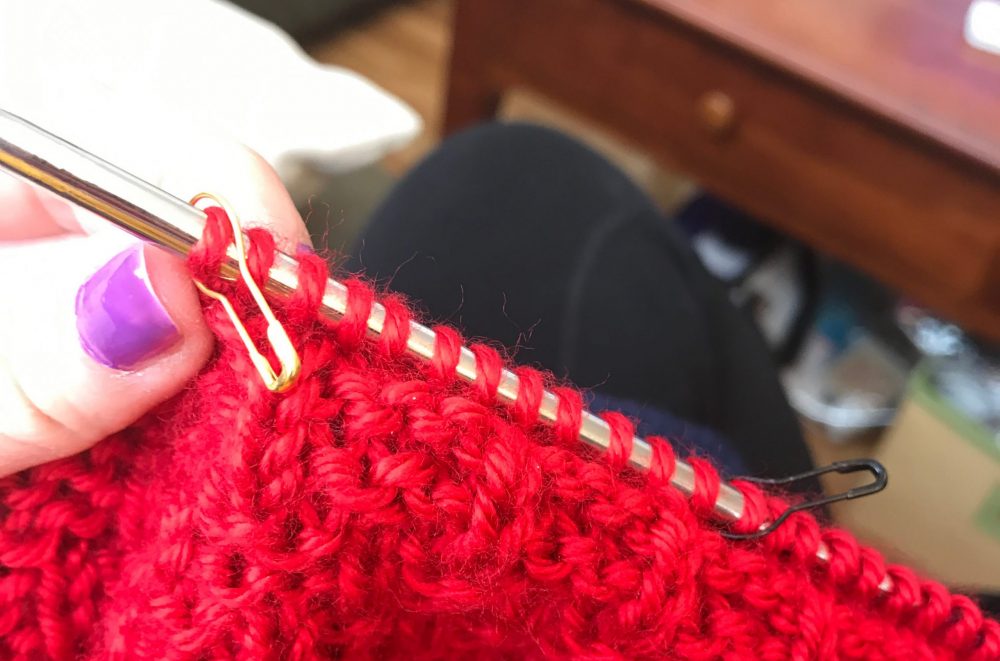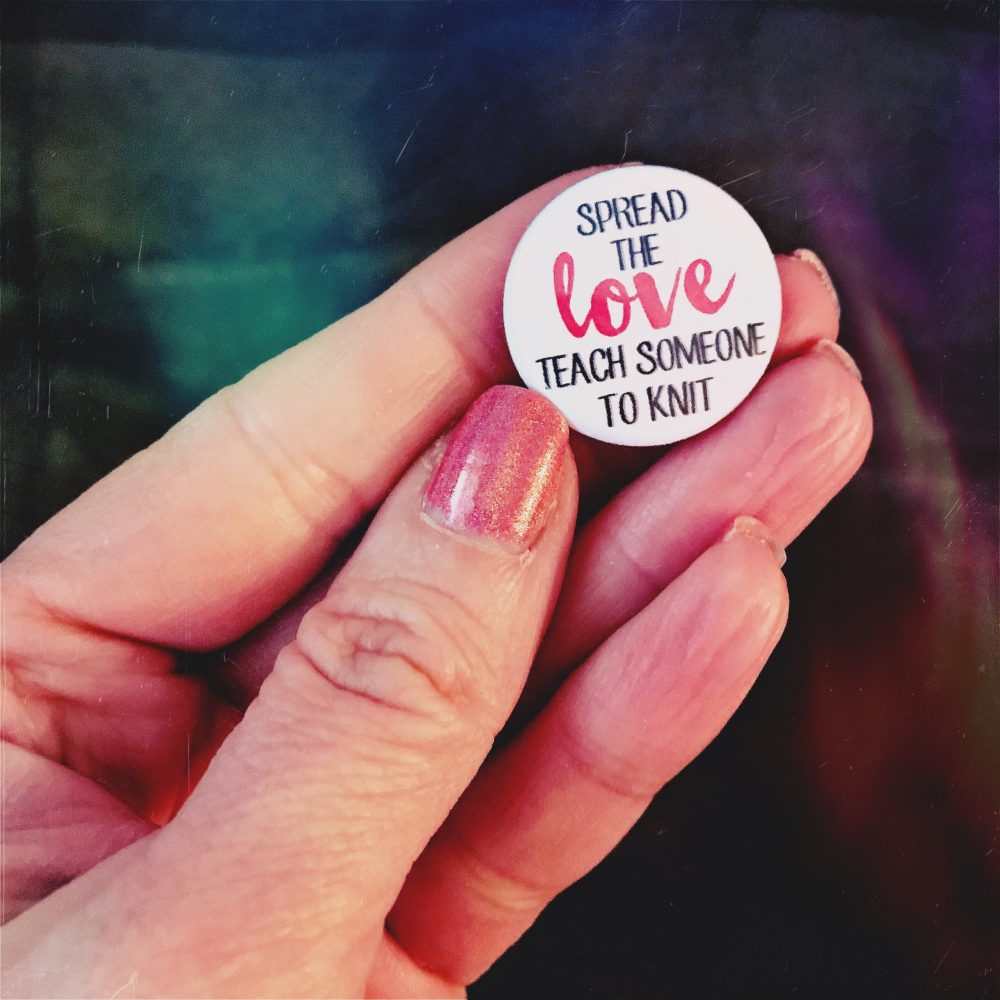Heads up! This post contains affiliate links which means I get may get a commission if you purchase something based on my recommendations here.
Knitting with double pointed needles can seem a little intimidating to beginners, but there’s no need to fear! Here are some easy solutions to two of the biggest issues knitters encounter when they work with DPNs, plus a little primer on how to organize and store your new favorite knitting needles!
How to Avoid Ladders When Knitting with DPNs
Sometimes when you’re knitting with double pointed needles, your tension might change when you jump from one needle to the next. When all of these loose stitches stack on top of each other, they look like a little ladder running up the side of your work, which is no fun! Here is a little swatch I whipped up to show you what laddering looks like:

The good news is that laddering is usually just a problem for your first projects. After time, your hands will learn how to keep your tension steady when you change needles – I promise! Still, you don’t want ladders on your creations, so as you are first learning to knit on DPNs the best solution is to alternate when you switch needles so the looser stitches don’t all stack up over each other. This isn’t something you’ll have to do forever, just think of it like using pair of training wheels while you learn to control your tension.
You may hear some very common advice that you can avoid ladders by pulling the first stitch on the new needle extra tight. I disagree with this advice. Your goal is to avoid tension changes as you move between needles, not to intentionally create one.
Also keep in mind that the tension that’s creating ladders may not be coming from the way you are managing your yarn: another cause of ladders can be the weight of your double pointed needles or your needle configuration. I’ll go into needle weight a little later, but when it comes to configuration there are two common set-ups: (1) you can work with four DPNS, where stitches are divided across three of those needles, arranged in a triangle and one is your working needle:

Or, (2) you can work with five DPNs with the working stitches divided over four needles arranged in a square:

The triangle configuration tends to tug more tightly at the joins and can contribute to ladders. The square formation tends to be a little more relaxed. A lot of knitters like the triangle configuration because less needle changes means your project whips up a bit faster, but I prefer the square.
How To Keep Stitches From Falling Off Your DPNs
Keep Stiches From Falling Off Your DPNS While You Knit
In my experience, it’s very rare for stitches to fall off your needles while you are actively knitting with double pointed needles. If this happens, it usually means you’re using the wrong kind of needles for your project. See my post on wood vs. metal knitting needles to understand which material is the best choice for your project, given your tension and stitch pattern. Also, consider the length of your double pointed needles. I love working with 5” DPNs for socks, but you can get a little extra insurance if you use 6” DPNs. If you’re doing hats or sleeves, you’ll want longer needles, obviously. I can’t work on 4” DPNs, they just don’t feel comfortable in my hands, but some knitters love them.
For some reason, I struggle to find metal DPNs in the 5” length, but it’s pretty common for wood needles. The majority of my sock-size wooden DPNs are made by Knit Picks – I love that they include 6 in each package in case you lose one. My favorite 6” DPNs are Knitter’s Pride Karbonz double pointed needles – they are kind of the best of both worlds with pointy metal tips but a light and grippy body made out of carbon, but acts similar to the qualities of wood. The only 5” metal needles I have found that are readily available in the US are Knitter’s Pride Smart Stix.
In general, you should aim for the lightest/shortest DPNs you can get because less weight = less laddering. But you need to make sure you’re picking the right material and a length that allows you to knit comfortably and avoid stitches falling off your needles while you work, or when you store your project.
Keep Stiches From Falling Off Your DPNS in Your Project Bag
I’m not too concerned about stitches falling off my DPNs while I work, but I have had SO MANY cases when my DPNs slipped out of the project while it was in my knitting bag so you always want to use a DPN holder.
There are two kinds of DPN holders that recommend. The first kind is like a little envelope that snaps closed. The second kind is made out of a thick strip of elastic with little fabric pockets sewn at each end. The second kind is my favorite style, but they are harder to find. (Although they’re fairly easy to DIY if you’re into sewing). The envelope kind are nice because they can hold projects on circular needles too, if you like double-duty knitting supplies.
I got both of the DPN holders below on Etsy: the Unicorn one is by JoPickleLily and the cat one is by StitchWithKoshka. I especially recommend StitchWithKoshka if you are looking for the elastic DPN holder to fit 5” DPNs – and if you love cats! It’s cat everything over there!

How to Store Double Pointed Needles
I store my knitting needles in their original sleeves and then I organize them by size in plastic envelopes in a soft binder. I’ve got all the details on that system here on my recommended knitting supplies list, so go check that out.

And there you have it! Hope these tips were helpful as you knit with double-pointed needles! If you have any tips to share, feel free to pop those in the comments!





Leave a Comment